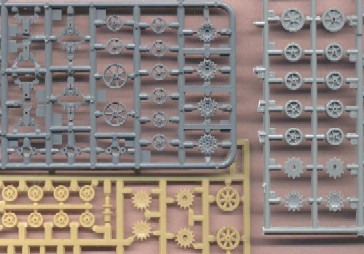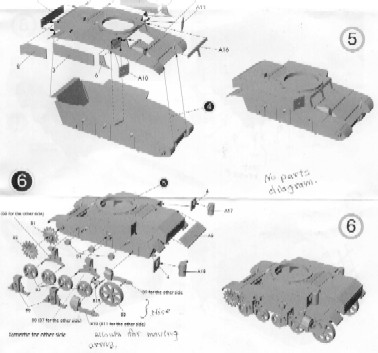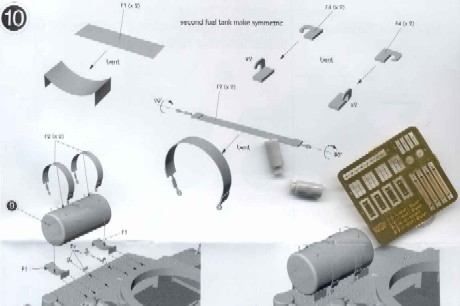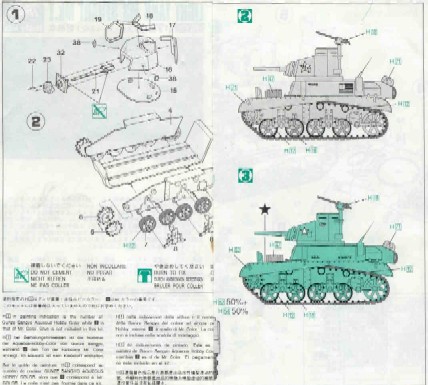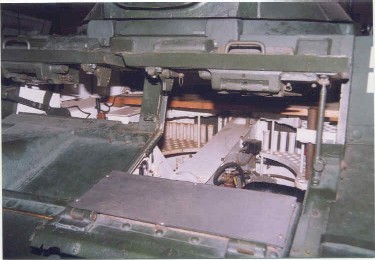In the box comparison review. M3
Stuart light tank By Stephen Brezinski
Vehicle
History for the Modeler
1) In May of 1942 production began on the M3A1, represented by Mirage’s kit #872112. The M3A1 is most obviously known for the deletion of the cupola but still with a horse shoe-shaped turret (type D58133). A significant change between the M3 and the M3A1 is the addition of a turret basket in the M3A1, and phasing out of the fixed sponson machine guns. The M3A1 also was produced with a welded hull. In between the M3 and the M3A1 is a tank referred to as the M3 “Hybrid”, this version looks externally like an M3A1, having no cupola, but the M3 Hybrid lacks the turret basket. Please keep in mind that for this review I only had the Mirage M3A1 Limited Release kit and I did not yet have their M3 nor M3A3 kits to examine. Many of the parts are the same between the three Mirage models and most of what is stated for the M3A1 kit should apply to Mirage’s M3 and M3A3 kits. Released with this are other Limited Release M3 variant kits. The Limited Release versions include resin and etched brass parts. Thanks to Milan Vin of Tracks & Troops for giving me this model to review.
2) The M3 series began with the riveted construction M3 with a riveted type D37812,eight-sided turret and with a prominent six-sided cupola, represented by Mirage’s M3 kit #72670. Only 100 of these were constructed before a switch was made to a welded octagonal turret. This early version served with US forces in the Philippines during 1942 and the Japanese used captured M3’s against US forces when the US Army returned to the Philippines in 1944.
3) The M3 turret was later changed to a welded octagonal turret (type D38976), represented by Hasegawa’s kit #MT3 500 [a.k.a. #31103]. Later the octagonal turret was dropped in favor of a welded horseshoe-shaped turret (type D39273) and with a prominent, lozenge-shaped cupola. The British introduced the designation ‘Stuart’ for this light tank though in the desert it was often referred to as the “Honey” because they like it so well due to its good armor and reliability. This version of the M3 served with British and US forces in North Africa, and with US forces in the Pacific theatre and in training. [Note that Matchbox’s 1/76 scale M3 kit offers both the octagonal and the horseshoe-shaped M3 turrets.] Though Hasegawa’s box art shows fuel drums stored on the sponsons, they are not included in Hasegawa’s M3 kit, and I have never seen them on an M3. My references state the drums were mounted only on the M3A1, as modeled by Mirage’s M3A1.
4) After M3A1 production ceased in January 1943, production began on the M3A3 that introduced features being perfected for the M5 light tank. The M3A3, represented by Mirage kit # 72676, introduced sloped welded armor, roof hatches for the driver and co-driver and a turret bustle. It resembled the M5A1 though had a flat engine deck with a different engine from the M5 and M5A1. The M3A3 was distributed as Lend Lease and served with the Free French, Polish, British and Chinese armies, etc. Mirage’s box art shows a French M3A3 during the liberation of Paris. Those interested in further information on the M3 light tank series should see my references below.
Kit
Comparison 6) Both Hasegawa and Matchbox include crew figures, and Hasegawa actually includes a horse and mounted US cavalry trooper. A good example of the comparison between the Hasegawa kit and the Mirage kit is in the outside AA machine gun. Mirage renders theirs in four parts while Hasegawa does their AA mg as only one part. Mirage’s mg barrels even have the perforations around the barrel, though I regret that the mg barrels are molded a little flattened. With all three kits I noted some ejector pin marks on several parts that will need filling but no sinkholes.
7) This is a comparison of the hull sides from the Hasegawa M3 [at top], Mirage M3A1 [in the center], and from the Matchbox M3 kit. Here and in the scans below we see that the Hasegawa kit is larger than the Mirage kit, which also advertises itself as 1/72 scale. Like the Hasegawa M4A3E8 Sherman and M3A1 halftrack kits I believe that this kit is also closer to 1/70 scale, not 1/72. Notice that on the Hasegawa and Matchbox kit, the inner parts of the roadwheel bogies are molded into the hull sides. Mirage is the only one of the three with completely separate bogies of five parts, meaning it will be easier to articulate the roadwheels over rough ground or a damaged vehicle missing a bogie.
8) The Hasegawa M3 kit at far left shows its age here and was no doubt a good kit when released years ago but does not compare well to the Mirage M3 in the center. Mirage offers more realistic rivet detail and separate handtools. When assembled the Mirage model will actually be slightly larger then appearing in the above scan as Mirage offers separate sides and rear plates so that Mirage could include rivet detail in all the appropriate areas. Because of a simpler molding process the rivet detail on the Hasegawa and Matchbox M3 models will not all be there. 9) Mirage’s and Hasegawa’s M3 models have the options of open driver’s and turret hatches. Matchbox’s M3 only allows the turret hatch to be modeled open. 10) The M3 and M3A1 all share the same basic suspension with open-spoke roadwheels and idler wheels, and a sprocket referred to as the “fancy” type. The wheel is where the greatest strengths and weaknesses show up when comparing these three kits. Mirage, at top left, got it too the absolute finest accurate detail. Both halves of the sprocket wheels are well detailed and match my reference photos very well. Hasegawa, at right, gives us solid spoke wheels, which I have not seen in any photos of an M3 or M3A1 [Some M5 light tanks did have solid roadwheels though.] Matchbox’s wheels, at bottom left in tan plastic, are comparable to Hasegawa’s but at least have open-spoke idler wheels 11) Here is a scan of the Mirage instructions showing the hull and bogie assembly. The Mirage instructions have four pages of exploded-view drawings in 11 steps, and are clear well done. The instructions remind me of those I have in an Extra Tech M10 model kit. Later steps show the turret assembly and attachment of the tools and tracks. There is no parts diagram that would help in finding and identifying the parts. 12) Mirage, Hasegawa and Matchbox kits all have soft band tracks molded in the live, flat-block, rubber style of tracks similar though narrower to that seen on early M4 Sherman tanks. I have see photos of M5 tanks with the later all-steel bar-tracks, but no M3’s or M3A1 light tanks. All three kit makers have done a decent job on their tracks though Mirage has the only tracks with inside detail. 13) Mirage’s Limited Edition M3A1 kit #872122 gives us a turned aluminum 37-mm gun barrel or we can use the kits injection-molded barrel (part C6). [I believe that Mirage’s regular M3 and M3A3 kits do not offer an aluminum barrel option.] Two 30-cal. M1919 machine guns (parts C17 ) are offered for the bow gun and the outside machine gun. These can instead be mounted in the sponsons (parts A10 & A11) and can be visible with the driver’s visor open. Hasegawa’s 37-mm gun (part 21) that appears too thick, closer to a 50-mm gun barrel. 14) Here is a another scan of the Mirage instructions showing the assembly of the brass and resin fuel drum parts that go atop the sponsons behind the turrets. [Though Hasegawa’s box art show their M3 version with these fuel drums, the Hasegawa kit does not actually include these drums in their kit.] I wish that Mirage had included etched brass light guards as well, an item in M3 and M4 tanks kits that is hard to render in plastic in this diminutive scale. The resin drums are the small light gray parts to the left of the etched brass fret.
15) Mirage’s M3A1 instructions include three multi-color pages showing markings placement for three M3A1 tanks of the US 1st Armored Division in North Africa. This scan shows Mirages water-slide decals, next to a small sheet of British Stuart decal-markings from the Matchbox kit. ACE makes a very nice set of decals for Lend Lease tanks in the Red Army [#D72001] with decals for six soviet M3’s or M3A1’s. 16) This is a scan of part of Hasegawa’s assembly and painting instructions. Decals and painting instructions are given for two olive drab US Army M3’s and a colorful British Stuart in the Western Desert. Hasegawa’s instructions have five assembly steps, and a parts diagram.
17) Here is the cast resin display for the Limited Edition Mirage M3A1 kit, which appears to be a well-rendered patch of the US 1st Armored “Old Ironsides” Division. I will make mine in tribute to my father-in-law who was with the 1st Armored through North Africa and Italy. Conclusion
References
http://www.armourinfocus.co.uk/m3/index.htm Chris Shillito’s Armour In Focus website with superb coverage of the M3 Stuart series.
STUART U.S. Light tanks In Action, Squadron Signal Publications, Armor No. 18, (1979) by Steve Zaloga & Don Greer. A good inexpensive soft cover book very much geared to modelers.
http://mailer.fsu.edu/~akirk/tanks/
TANKS! Armoured Warfare Prior To 1946 website. A great website with
photos and brief history of the M3 [and many other AFV’s] in
service with many nations.
|






